Thoracic Pain: Contributing factors and how to reverse it
Hey, you there! Slouching over at your desk reading this blog post, sit up tall! If you’ve been feeling a nagging ache in the middle of your back, you’re not alone. This is a very common region for people of today’s world to have discomfort, it is largely in part because of our job requirements (aka: sitting at a desk all day), along with scrolling on our phones. The good news is that with a base level understanding and simple exercises, you can take control of that irritating back pain and feel better!
The thoracic spine, which is often referred to as the mid-back, consists of 12 vertebrae, all of which have a rib attached to them. It is common, due to the posture of the general population, to have pain somewhere along the central region of the mid-back and even between the ribs. The main culprits that could be causing the pain could be the stiffening of the vertebral joints themselves, the joint region between the rib and vertebrae, overworked shoulder blade muscles that are helping you sit upright, and even overstretched muscles that have become weak over time. Think of your back like a chain, if one link in the chain is “kinked”, the whole system feels the strain.
The best way to ease mid-thoracic pain is to get moving, even though it might be stiff or sore at first, as you move the joints and muscles this will begin to decrease stiffness and/or tension throughout the restricted regions. We also can’t forget about the weak muscles, these need to be strengthened in order to help maintain the proper upright posture, without having to think too much about it.
To start, we’ll go in to some exercises to help loosen up that mid-back and strengthen some of those postural muscles we mentioned.
The first stretch is the thoracic extension stretch. This does a good job of reversing that forward slump by opening up your upper back. Hold this position for 5-10 seconds, return to neutral posture, and repeat 5-10 times.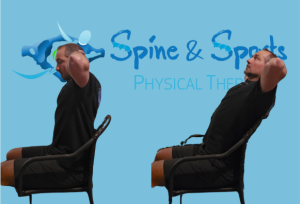
The second stretch being the cat-cow stretch. This is a classic yoga movement that gets the entirety of the spine moving smoothly. Follow the same guidelines for prescription as the last stretch; hold each position for 5-10 seconds and repeat 5-10 times.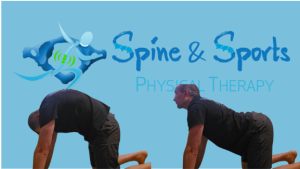
Next, the seated thoracic rotation stretch. This will help your ability to twist your upper back, which can stiffen up from sitting too long. All you will need for this one is a chair! Hold each position for 5-10 seconds, complete the stretch on each side for 4-5 reps. 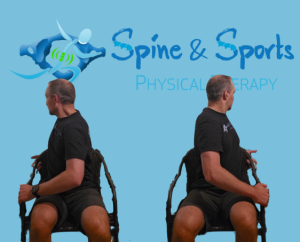
The last two are strengthening exercises, T’s and Y’s. They will either require a resistance band, or light weights to complete. For these, you should choose a resistance that completing 12-15 reps with is a challenge but is still doable. An image for both the use of a resistance band and/or a dumbbells is below. One key point we will make for these two exercises is to make sure you are squeezing the shoulder blades together at the end of each repetition you complete!
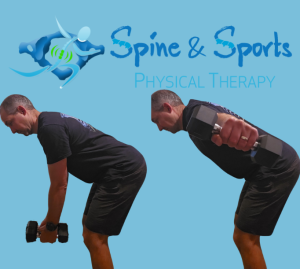
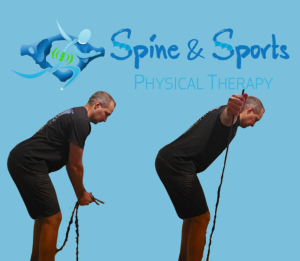
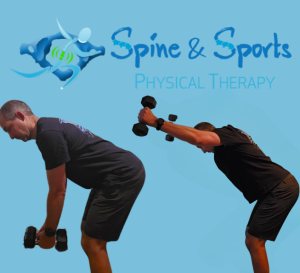
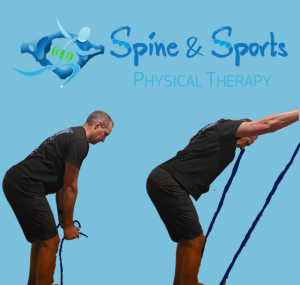
Our last few tips for a happier back would be to break up sitting time, be aware of your posture, and move more! Often, we tell people to set a timer on your phone for every 20-30 minutes as a reminder to get up and walk around the room/office you are working in for 1-2 minutes, we are not designed to live in one posture for hours at a time. Also, take a sticky note and write yourself a little reminder to put on to the border of the screen or surface you are using to maintain proper posture. It can be as simple as one word, “Posture!” Finally, set a movement goal for yourself! Whether you choose to set the goal in terms of calories, miles, steps, or walking time. As a society, we have become very stagnant. Even as physical therapists, we can be guilty of that as well at times, but, we keep each other in check and that’s what we are here to do for you as well!
If you find that you are continuing to have pain after several weeks of trying these exercises, give us a call to schedule an evaluation. Sometimes these conditions require a little outside help from a skilled Physical Therapist to get you back on track! We’ll dive deeper into some other areas and tests to provide you with more personalized treatments based on your specific findings and goals.
